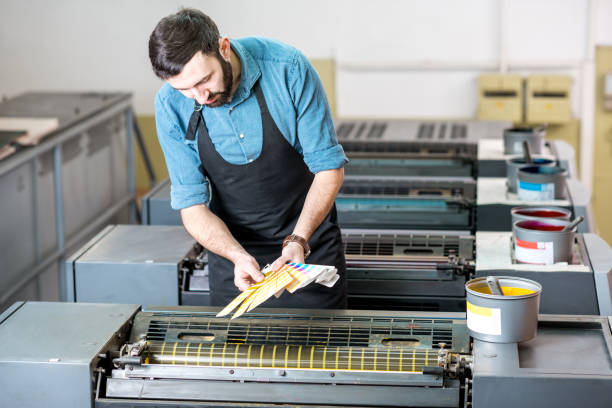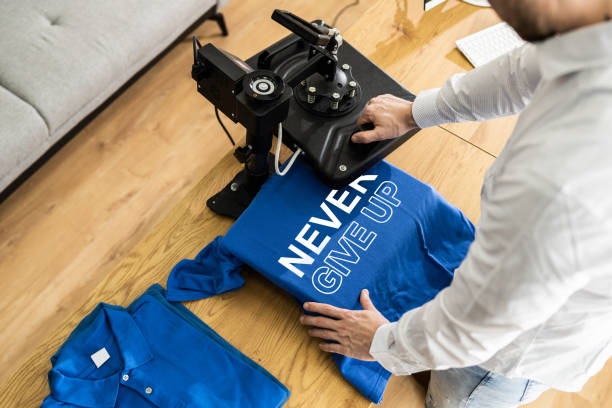The t-shirt printing industry is booming, with the custom apparel market expected to reach $10 billion by 2025. For aspiring entrepreneurs, creative individuals, and anyone seeking a profitable home-based business, starting a t-shirt printing venture offers an exciting opportunity with relatively low barriers to entry.
Starting a home-based t-shirt printing business combines creative expression with entrepreneurial spirit. You can turn artistic designs into profitable products while enjoying the flexibility of working from home. The beauty of this business model lies in its scalability—you can begin with minimal investment and gradually expand as your customer base grows.
This comprehensive guide will walk you through every aspect of launching your t-shirt printing business from home. You’ll discover how to conduct market research, choose the right equipment, master different printing techniques, and navigate legal requirements. Whether you’re looking for a side hustle or planning to build a full-time enterprise, this roadmap will help you transform your creative vision into a thriving business.
From successful brands like Johnny Cupcakes, which started as a unique concept with strong branding, to community-driven platforms like Threadless that empower artists, the t-shirt printing industry offers multiple paths to success. Your journey begins with understanding your market and crafting a solid foundation for growth.
Understanding Your Market and Finding Your Niche
Before investing in equipment or creating designs, thorough market research forms the cornerstone of your t-shirt business success. Start by identifying your target audience and understanding their preferences, purchasing behavior, and pain points.
Analyze your local market and online competitors to identify gaps you can fill. Study successful brands like Custom Ink, which built their reputation on excellent customer service for custom orders, or Printful, which revolutionized the print-on-demand space by seamlessly integrating with e-commerce platforms.
Your niche could be anything from funny pet-themed shirts to motivational quotes for fitness enthusiasts. The key is specificity—rather than trying to appeal to everyone, focus on a particular demographic or interest group. Research social media groups, forums, and online communities where your potential customers gather.
Consider seasonal trends, local events, and emerging cultural movements that might influence design demand. Tools like Google Trends, social media analytics, and competitor analysis will help you understand market dynamics and identify profitable opportunities.
Creating a Solid Business Plan

A well-structured business plan serves as your roadmap to success and helps secure funding if needed. Your plan should outline your business concept, target market analysis, competitive landscape, marketing strategy, and financial projections.
Define your unique selling proposition clearly. What sets your t-shirt business apart? Perhaps it’s eco-friendly materials, lightning-fast turnaround times, or exclusive designs from local artists. Your USP should address specific customer needs that competitors aren’t meeting effectively.
Include realistic financial projections covering startup costs, ongoing expenses, and revenue forecasts. Factor in seasonal fluctuations and potential challenges like supply chain disruptions or increased competition.
Set measurable goals for your first year, including sales targets, customer acquisition numbers, and expansion milestones. Establish key performance indicators (KPIs) to track progress and make data-driven decisions about business growth and strategy adjustments.
Essential Equipment and Supplies
Your equipment needs depend on your chosen printing method and budget. For beginners, print-on-demand services offer the lowest barrier to entry, requiring just $500-$1,000 for design costs, marketing, and sample prints.
Basic Startup (Print-on-Demand): $500-$1,000
- Computer and design software
- Digital camera for product photos
- Basic marketing materials
- Sample products for quality testing
Intermediate Setup (DTG or Heat Transfer): $3,000-$7,000
- DTG printer or professional heat press
- Vinyl cutter for heat transfer designs
- RIP software for color management
- Initial inventory of blank shirts
- Heat transfer vinyl or DTG inks
Advanced Setup (Screen Printing): $10,000-$20,000+
- Multi-station screen printing press
- Squeegees, screens, and frames
- Emulsion and chemicals
- Exposure unit and washout booth
- Professional dryer or conveyor system
Research suppliers carefully, comparing quality, pricing, and reliability. Establish relationships with multiple suppliers to avoid disruptions. Consider factors like minimum order quantities, shipping costs, and return policies when selecting partners.
Mastering Printing Techniques

Understanding different printing methods helps you choose the best approach for your business model and target market. Each technique has unique advantages, limitations, and cost structures.
Screen Printing
Screen printing works best for large orders with simple designs and limited colors. This method offers excellent durability and vibrant colors, making it ideal for bulk orders from schools, businesses, or events.
The process involves creating screens for each color in your design, then pushing ink through the screens onto shirts. While setup costs are high, per-unit costs decrease significantly with larger quantities, typically making screen printing most economical for orders over 50 pieces.
Direct-to-Garment (DTG) Printing
DTG printing excels at producing complex, multi-colored designs with photo-quality detail. This method works like an inkjet printer, applying water-based inks directly onto fabric fibers.
DTG is perfect for small batches, custom orders, and designs with gradients or photographic elements. The technology allows for unlimited colors without additional setup costs, making it ideal for personalized products and limited-edition designs.
Heat Transfer
Heat transfer vinyl (HTV) and heat transfer printing offer versatility and relatively low startup costs. This method works well for text-based designs, simple graphics, and specialty materials like glitter or metallic finishes.
Heat transfer is excellent for beginners because it requires minimal equipment and allows for easy experimentation with different materials and techniques. However, durability may be lower than screen printing or DTG for heavily used garments.
Design Creation and Marketing Strategies

Strong designs form the heart of your t-shirt business. Whether you create designs yourself or work with freelance artists, focus on originality, quality, and market appeal. Study trending topics, popular culture, and your target audience’s interests to create relevant, engaging designs.
Invest in professional design software like Adobe Illustrator or explore free alternatives like Canva or GIMP. Ensure your designs are high-resolution and properly formatted for your chosen printing method.
Develop a consistent brand identity across all touchpoints, from your logo and color scheme to your social media presence and packaging. Successful brands like Johnny Cupcakes built loyal followings through unique branding and storytelling.
Marketing your home-based t-shirt business requires creativity and consistency. Leverage social media platforms where your target audience spends time. Instagram and TikTok work well for visual products, while Facebook and Pinterest can drive traffic and sales.
Consider influencer partnerships, local craft fairs, and pop-up events to build brand awareness. Email marketing remains highly effective for customer retention and repeat sales.
Content marketing through blogs, tutorials, or behind-the-scenes videos helps establish authority and connect with customers on a deeper level. Share your design process, printing techniques, or business journey to build authentic relationships with your audience.
Legal and Financial Considerations

Proper legal structure protects your personal assets and establishes credibility with customers and suppliers. Choose between sole proprietorship, LLC, or corporation based on your growth plans, liability concerns, and tax considerations.
Business Registration and Licensing
Register your business name and obtain necessary licenses for your location. Many home-based businesses require general business licenses, and some areas have specific regulations for manufacturing or retail operations.
Obtain a Federal Tax ID (EIN) from the IRS, especially if you plan to hire employees or operate as anything other than a sole proprietorship. This number is essential for opening business bank accounts and establishing vendor relationships.
Intellectual Property Protection
Ensure all your designs are original or properly licensed to avoid copyright infringement lawsuits. Respect existing trademarks and branding rights. Consider registering your own designs and business name as trademarks for added protection.
Create clear contracts with any freelance designers, suppliers, or employees. These agreements should define ownership of designs, payment terms, confidentiality requirements, and dispute resolution procedures.
Insurance and Compliance
Secure appropriate business insurance, including general liability, product liability, and property coverage. Insurance protects against customer injuries, product defects, equipment damage, and other unforeseen circumstances.
Understand your obligations for collecting and remitting sales tax in jurisdictions where you sell products. E-commerce platforms often handle this automatically, but direct sales may require manual tax management.
Implement proper record-keeping systems for financial transactions, inventory, and tax purposes. Good records simplify tax filing, help track profitability, and support business loan applications.
Growth Strategies and Scaling Your Business
Success in the t-shirt printing industry requires continuous adaptation and strategic growth planning. Monitor your key performance indicators regularly and adjust strategies based on data and market feedback.
Expand your product line gradually, testing new items with existing customers before major investments. Consider complementary products like hoodies, tote bags, or hats that align with your brand and utilize similar printing processes.
Develop systems and processes that support growth without compromising quality. This might include inventory management software, automated order processing, or standardized quality control procedures.
Consider strategic partnerships with local businesses, artists, or organizations. Collaborations can expand your reach, reduce marketing costs, and create unique products that differentiate your brand.
Explore different sales channels as your business grows. While you might start with direct sales and social media, consider platforms like Etsy, Amazon, or your own e-commerce website to reach broader audiences.
Invest in customer relationship management (CRM) tools to track customer preferences, purchase history, and communication. Loyal customers often become your best marketing asset through word-of-mouth referrals and repeat purchases.
FAQ How to Start a Small T-Shirt Printing Business From Home
How much money do I need to start a t-shirt printing business from home?
Startup costs vary significantly based on your chosen printing method. Print-on-demand models require $500-$1,000, while DTG setups need $3,000-$7,000. Screen printing operations typically require $10,000-$20,000+ in initial investment. Factor in ongoing monthly costs of $100-$500 for materials, marketing, and operational expenses.
What printing method is best for beginners?
Print-on-demand services offer the lowest risk and investment for beginners. Companies like Printful handle printing, inventory, and shipping, allowing you to focus on design and marketing. Heat transfer is another beginner-friendly option with low equipment costs and quick learning curve.
How do I protect my designs from being copied?
Register original designs as copyrights with the U.S. Copyright Office for maximum legal protection. Use watermarks on online images and monitor competitors for potential infringement. Consider working with intellectual property attorneys for valuable designs or if infringement occurs.
Where can I find reliable suppliers for blank t-shirts?
Research wholesale suppliers like Bella+Canvas, Next Level Apparel, or Gildan for quality blank shirts. Compare pricing, minimum orders, shipping costs, and return policies. Establish relationships with multiple suppliers to ensure consistent inventory and competitive pricing.
How long does it take to become profitable?
Profitability timelines vary based on startup costs, pricing strategy, and market demand. Print-on-demand businesses might see profits within 3-6 months, while equipment-heavy operations may require 6-18 months to recoup initial investments. Focus on building a loyal customer base and optimizing operations for long-term success.
Do I need special permits to run a t-shirt business from home?
Home business requirements vary by location. Most areas require general business licenses, and some have specific regulations for manufacturing or retail operations. Check with local authorities about zoning restrictions, noise ordinances, and any special permits needed for commercial activities in residential areas.
Building Your T-Shirt Empire Starts Today
Starting a t-shirt printing business from home offers tremendous opportunities for creative entrepreneurs willing to invest time in planning and execution. The combination of relatively low startup costs, scalability potential, and creative freedom makes this an attractive venture for those seeking financial independence.
Success depends on understanding your market, choosing appropriate equipment and printing methods, creating compelling designs, and building strong customer relationships. Legal compliance and proper business structure protect your investment and support sustainable growth.
Remember that building a profitable t-shirt business takes time, persistence, and continuous learning. Start small, test your concepts, and scale based on proven demand and customer feedback.
Your journey begins with taking the first step. Research your local market, identify your niche, and create a business plan that aligns with your goals and resources. The t-shirt printing industry rewards those who combine creativity with business acumen, offering unlimited potential for growth and success.
Transform your creative vision into a thriving home-based business. Your customers are waiting for the unique designs and quality products only you can provide.
